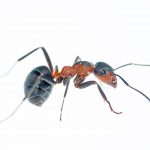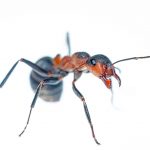Lihou BioBlitz What an incredible day we had at Lihou...
Read MoreExciting Ant News...
... we have a newly discovered Formica pratensis nest.
11th September 2020
In Guernsey, black-backed meadow ants, Formica pratensis, are typically found on the south cliffs. This rare ant species is Near Threatened on the IUCN Red List, so we survey the nests every year and mark their nests with red flags so the land management team can see them.
This September, while wandering the lanes of St Saviour, a long way from the south cliffs, Russell Le Conte took this photo.
Could it be?
A black-backed meadow ant, Formica pratensis, nest so far from what we consider their normal habitat?
A flurry of emails back and forth and Julie, our Ant Survey Coordinator, headed off in search of the nest. Other local entomologists made plans to visit it. Julie swiftly reported back she was reasonably certain it was F. pratensis, especially as there was a mound – which is a key identifier. The nest was about 60 x 60 cm, very active and in good condition. It appears to be quite on its own as she checked the nearby banks.
Andy Marquis and Barry Wells investigated too, returning with some incredible macro-photographs. Click on the photos to see close up image.
what3words
How did we track down the nest site so quickly?
Anyone who has ventured into the twisting lanes of St. Saviour knows that it can be tricky to find where you are going. Perry’s Guide is much more helpful than latitude and longitude but it can still take a while
Russell sent in the location using what3words. This means the location of the nest was pinned down to a 3 metre square area and Julie found it really quickly.
Visit Guernsey partnered with what3words at the start of 2020 to help people find hidden gems but we’re finding it really helpful to pin down wildlife sightings. You don’t need to read a map and even better, especially on the cliffs where there is limited phone coverage, you can use this free app offline. This means it also doesn’t eat up your data.
Everything suggested that this nest might be a remnant of a population that used to be far more widespread in years gone by. Ant expert Phil Attewell was approached and, this week, we got confirmation.
Phil Attewell identification:
Yes, definitely Formica pratensis. A nice find, and confirmation that these isolated inland nests are still surviving, and apparently thriving, in the lanes where they seem to have cropped up here and there over the years in Guernsey, and were on the maps that Charles David used to produce. Good to see a brand new one!
Isolated single nests are the usual norm for F. pratensis. The apparently mutually friendly ‘supercolonial’, probably polygynous, nests of the Guernsey cliffs are not its traditional habit elsewhere, although similar populations are recorded in some sites, e.g. one or two places in the Netherlands, as Cedric Collingwoood used to tell me about.
Single, isolated nests like this one will have been started by a mated female having flown from its mother nest, and ‘taken over’ a nest of either F. fusca or F. cunicularia, by entering it and usurping the existing queen. On the cliffs, I think new nests are mostly started by mated queens going off with a few workers from their mother nest (“splitting” or “fission”), or simply attracting passing workers to them – “worker capture”, as it’s sometimes known. Wood ant queens cannot start colonies unaided. The two modes of colony reproduction are therefore in evidence on Guernsey.
The isolated nests will therefore usually only live as long as the founding queen (monogyny). There must be many dotted about undiscovered in open hedges and on lane banks.
The weather this year on the whole must have been good for the F. pratensis, although the recent very wet and relatively cool spell will have been unwelcome.
Bailiwick Bat Survey
Bailiwick Bat Survey Citizen Science Project 15th April 2021 The...
Read MoreThe Love of Invertebrates
The Love of Invertebrates Andy Marquis Guernsey Wildlife 2nd March...
Read MoreJanuary 2021 Lockdown
Further update: 19th February 2021 This week the States of...
Read More


